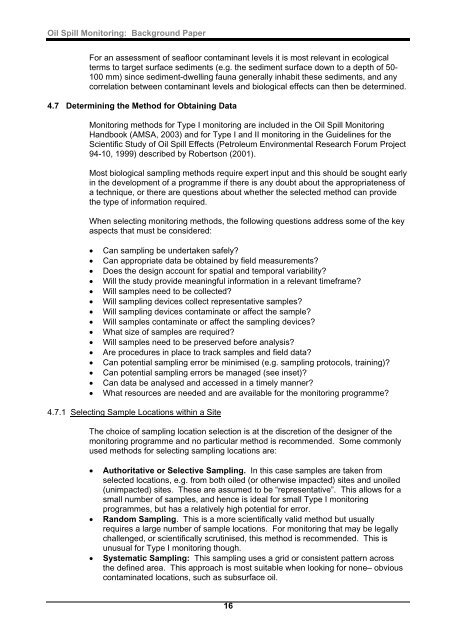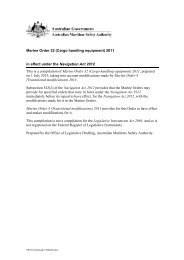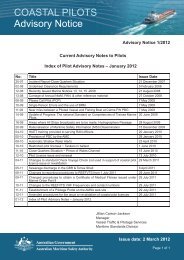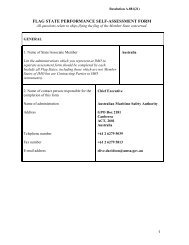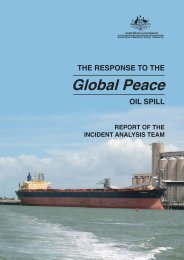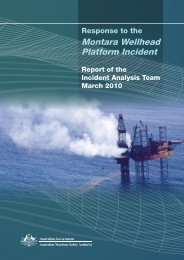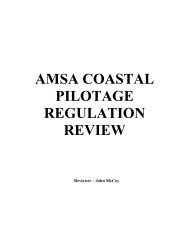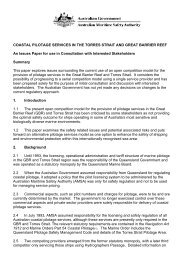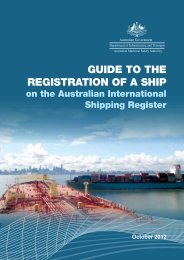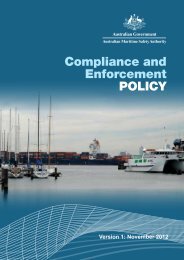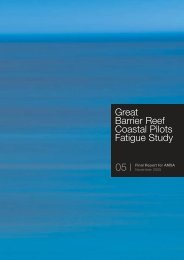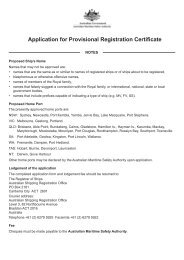Oil Spill Monitoring BACKGROUND PAPER - Australian Maritime ...
Oil Spill Monitoring BACKGROUND PAPER - Australian Maritime ...
Oil Spill Monitoring BACKGROUND PAPER - Australian Maritime ...
Create successful ePaper yourself
Turn your PDF publications into a flip-book with our unique Google optimized e-Paper software.
<strong>Oil</strong> <strong>Spill</strong> <strong>Monitoring</strong>: Background Paper<br />
For an assessment of seafloor contaminant levels it is most relevant in ecological<br />
terms to target surface sediments (e.g. the sediment surface down to a depth of 50-<br />
100 mm) since sediment-dwelling fauna generally inhabit these sediments, and any<br />
correlation between contaminant levels and biological effects can then be determined.<br />
4.7 Determining the Method for Obtaining Data<br />
<strong>Monitoring</strong> methods for Type I monitoring are included in the <strong>Oil</strong> <strong>Spill</strong> <strong>Monitoring</strong><br />
Handbook (AMSA, 2003) and for Type I and II monitoring in the Guidelines for the<br />
Scientific Study of <strong>Oil</strong> <strong>Spill</strong> Effects (Petroleum Environmental Research Forum Project<br />
94-10, 1999) described by Robertson (2001).<br />
Most biological sampling methods require expert input and this should be sought early<br />
in the development of a programme if there is any doubt about the appropriateness of<br />
a technique, or there are questions about whether the selected method can provide<br />
the type of information required.<br />
When selecting monitoring methods, the following questions address some of the key<br />
aspects that must be considered:<br />
• Can sampling be undertaken safely?<br />
• Can appropriate data be obtained by field measurements?<br />
• Does the design account for spatial and temporal variability?<br />
• Will the study provide meaningful information in a relevant timeframe?<br />
• Will samples need to be collected?<br />
• Will sampling devices collect representative samples?<br />
• Will sampling devices contaminate or affect the sample?<br />
• Will samples contaminate or affect the sampling devices?<br />
• What size of samples are required?<br />
• Will samples need to be preserved before analysis?<br />
• Are procedures in place to track samples and field data?<br />
• Can potential sampling error be minimised (e.g. sampling protocols, training)?<br />
• Can potential sampling errors be managed (see inset)?<br />
• Can data be analysed and accessed in a timely manner?<br />
• What resources are needed and are available for the monitoring programme?<br />
4.7.1 Selecting Sample Locations within a Site<br />
The choice of sampling location selection is at the discretion of the designer of the<br />
monitoring programme and no particular method is recommended. Some commonly<br />
used methods for selecting sampling locations are:<br />
• Authoritative or Selective Sampling. In this case samples are taken from<br />
selected locations, e.g. from both oiled (or otherwise impacted) sites and unoiled<br />
(unimpacted) sites. These are assumed to be “representative”. This allows for a<br />
small number of samples, and hence is ideal for small Type I monitoring<br />
programmes, but has a relatively high potential for error.<br />
• Random Sampling. This is a more scientifically valid method but usually<br />
requires a large number of sample locations. For monitoring that may be legally<br />
challenged, or scientifically scrutinised, this method is recommended. This is<br />
unusual for Type I monitoring though.<br />
• Systematic Sampling: This sampling uses a grid or consistent pattern across<br />
the defined area. This approach is most suitable when looking for none– obvious<br />
contaminated locations, such as subsurface oil.<br />
16


